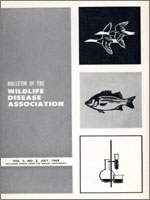The relationship between the California encephalitis (CEV) group of arboviruses and a snowshoe hare population near Rochester (54N, 113W), Alberta has been studied since 1961. The neutralizing antibody prevalence to the CEV group of viruses in adult hares was high, 58% to 95%, during the 6 years of snowshoe hare population decline, when the population dropped from over 600 hares per square mile to 3 hares per square mile. In the 2 years of population recovery thus far observed, the antibody prevalence has been low, 0% to 43%. The prevalence rates in juveniles have been lower than in the adults throughout the study. At least 2 strains of the virus group are present and a total of 7 isolations from Aedes mosquitoes and 1 from a snowshoe hare have been made, representing the northern most known limit of the CEV froup in North America. Experimental viremia studies with the Montana snowshoe hare strain of virus resulted in titers up to 104 mouse LD50 per ml. of whole blood and viremia lasted up to 3 days with an increase in length of viremia with age.
BioOne.org will be down briefly for maintenance on 17 December 2024 between 18:00-22:00 Pacific Time US. We apologize for any inconvenience.
How to translate text using browser tools
1 July 1969
SNOWSHOE HARES AND THE CALIFORNIA ENCEPHALITIS VIRUS GROUP IN ALBERTA, 1961–1968
G. L. HOFF,
T. M. YUILL,
J. O. IVERSEN,
R. P. HANSON





